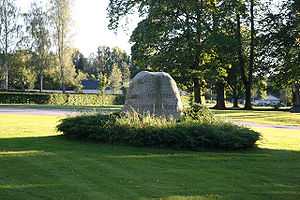Eidsivating

Eidsivating was the name of one of the original Norwegian popular assemblies or Tings. Historically it was the site of court and assembly for the eastern parts of Norway.[1]
Traditionally Eidsivating was the court for the population around Lake Mjøsa. Eidsivating was originally situated at Åker gård, the seat of Vang in Hedmark county, Norway. When Norway was united as a kingdom, the first lagtings were constituted as superior regional assemblies, Eidsivating being one of them. These were representative assemblies at which delegates from the various districts in each region met to award legal judgments and pass laws (Eidsivatingloven). Later, during the time of St. Olav, the court was moved to Eidsvold.[2][3]
The ancient regional assemblies – Frostating, Gulating and Eidsivating – were eventually joined into a single jurisdiction. King Magnus Lagabøte had the existing body of law put into writing (1263–1280). This compilation of the codified Gulating laws (Gulatingsloven) applied throughout the realm was exceptional for its time. This code remained in force until Frederik III, king of the Dano-Norwegian personal union, promulgated absolute monarchy in 1660. Peder Schumacher Griffenfeld prepared a document which would form the King's Law (Kongeloven) dated 14 November 1665. This was codified in the King Act of 1665 which functioned as the constitution of the Union of Denmark-Norway until 1814.[4][5]
In 1046 Field was a likely place for a conciliation meeting between Magnus the Good, the then king, and Harald Hardrada, who came back from Byzantium. Harold was recognized as co-ruler.